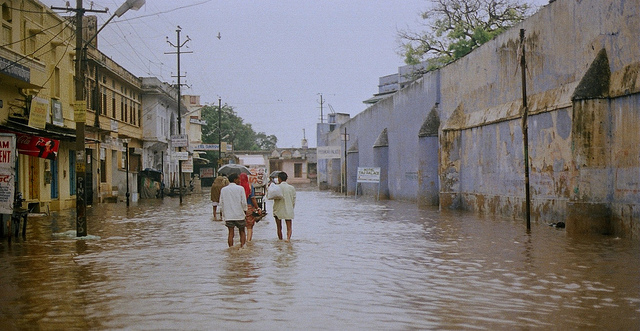Chennai Floods: A Tragedy Foretold

Occurrence of The Tragedy
The tragedy of the recent Chennai floods, which, mercifully, as of Saturday has begun to abate, is that it could have been avoided (another matter that the city displayed tremendous character in dealing with the crisis, just as social media once again showed us that it is a key tool in assisting rescuers and, in some cases, saving the trapped.) In the case of Chennai, there was one key cause: the Adyar river basin being taken over for the new airport, just as other stretches have been used to develop residential spaces. Denied its natural path, excess water flooded the neighborhood. Until nature unleashed its excess, planners ignored the risks and results are in front of us now.
Some Major Disasters in India
We have seen this pattern play out earlier in Mumbai and more recently in the devastating floods that gutted Srinagar. In almost every instance, the central cause is easy to ascertain: unplanned urbanization inspired by an utter disregard for basic norms. Yet, every time the import of the tragedy fades along with public memory. Like in Chennai, a disaster is waiting to happen in Delhi, with authorities, in their wisdom, allowing some of the flood plains to accommodate the swanky Commonwealth Games village.
It is this business-as-usual approach that is worrying. This struck home with the passing of another dubious milestone last week: The 31st anniversary of the Bhopal gas tragedy—India’s worst industrial disaster. It passed by almost unnoticed (unlike its 30th anniversary). The tragedy, as in the case of Chennai, is that there is no evidence that any lessons have been learnt, leave alone the fact that the inadequately compensated people affected by the tragedy are still dealing with the deadly consequences of the methyl isocyanate gas leak.
Vulnerability of India to Disasters
It is not just the frequency of disasters—which is alarmingly on the rise—it is that the country is particularly risk-prone. Due to a combination of topography and high population density, India is particularly vulnerable to disasters, and the authorities are well aware of it.
Role of the NDMA
The National Disaster Management Authority (NDMA), the apex body for disaster management, provides us a risk profile on its website:
More than 58.6% of the landmass is prone to earthquakes of moderate to very high intensity. More than 40 million hectares (12%) of its land is prone to floods and river erosion. Close to 5,700km, out of the 7,516km long coastline, is prone to cyclones and tsunamis. 68% of its cultivable area is vulnerable to droughts (several states, particularly in central and north India, are suffering the ravages of back-to-back droughts in the past two years). Its hilly areas are at risk from landslides and avalanches (as the flash floods in Leh and Ladakh underlined in 2010).
The NDMA’s website has this humbling homily to add: “Disaster risks in India are further compounded by increasing vulnerabilities related to changing demographics and socioeconomic conditions, unplanned urbanization, development within high-risk zones, environmental degradation, climate change, geological hazards, epidemics and pandemics.”
And what it says next is what should serve as a wake-up call to all—governments as well as citizens. Clearly, all these “contribute to a situation where disasters seriously threaten India’s economy, its population and sustainable development”. If this is not enough to drive home the point, then check out a recent report by the World Resources Institute (WRI), which says that India tops the list of 163 nations affected by river floods in terms of the number of people. According to it, every year, the lives of 4.85 million Indians are disrupted by floods, risking $14.3 billion of gross domestic product.
Solutions And Precautions
Here are some safety tips to prepare for rising water—and what to do once a flood has begun.
Safety Tips
Before a Flood
Avoid building in a floodplain. Construct barriers (levees, beams, floodwalls) to stop floodwater from entering your home. Seal walls in basements with waterproofing compounds to avoid seepage. If a flood is likely in your area, listen to the radio or television for information. Know the difference between a flood watch and a flood warning. A watch means flooding is possible. A warning means flooding is occurring or will occur soon.
When a Flood is Imminent
Be prepared! Pack a bag with important items in case you need to evacuate. Don’t forget to include needed medications. If advised to evacuate your home, do so immediately. If there is any possibility of a flash flood, move immediately to higher ground. If possible, bring in outdoor furniture and move essential items to an upper floor. Turn off utilities at the main switches or valves if instructed to do so. Disconnect electrical appliances.
During a Flood
Do not walk through moving water. As little as 6 inches (15 centimeters) of moving water can make you fall. You have to walk in water, wherever possible, walk where the water is not moving. Use a stick to check the firmness of the ground in front of you. Do not drive into flooded areas. If floodwaters rise around your car, abandon the car and move to higher ground if you can do so safely. Do not touch electrical equipment if you are wet or standing in water.
After a Flood
Listen for news reports to learn whether the community’s water supply is safe to drink. Avoid floodwaters; water may be contaminated by oil, gasoline, or raw sewage. Water may also be electrically charged from underground or downed power lines. Avoid moving water. Be aware of areas where floodwaters have receded. Roads may have weakened and could collapse under the weight of a car. Stay away from downed power lines, and report them to the power company. Return home only when authorities indicate it is safe. Stay out of any building if it is surrounded by floodwaters.
Service damaged septic tanks, cesspools, pits, and leaching systems as soon as possible. Damaged sewage systems are serious health hazards. Clean and disinfect everything that got wet. Mud left from floodwater can contain sewage and chemicals.
Why Opt For Sustainability?
It is apparent then that India is at risk from disasters. It is also obvious that urbanization and high-density population pockets are emerging as the new way of life. Take the two together and there is only one conclusion: without sustainability, India’s urbanization is a recipe for disaster.
Concluding, we are all deeply affected by the devastation wreaked on the city of Chennai by the fury of nature. At the same time, the resilience of the people of Chennai and the way in which the community has come together to help each other and face this adversity is remarkable and makes us all feel proud. We appreciate the massive effort undertaken by the Chennai government and everyone in Chennai, to deal with this calamity and we hope everyone’s contribution will help in a small way.
[Image Attribute: Pushkar]




